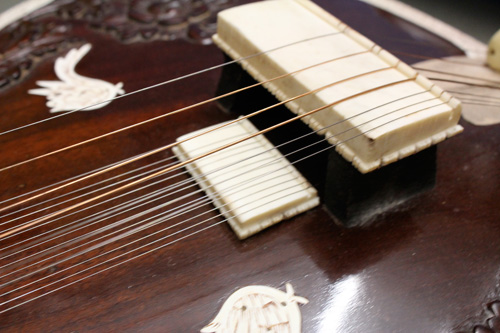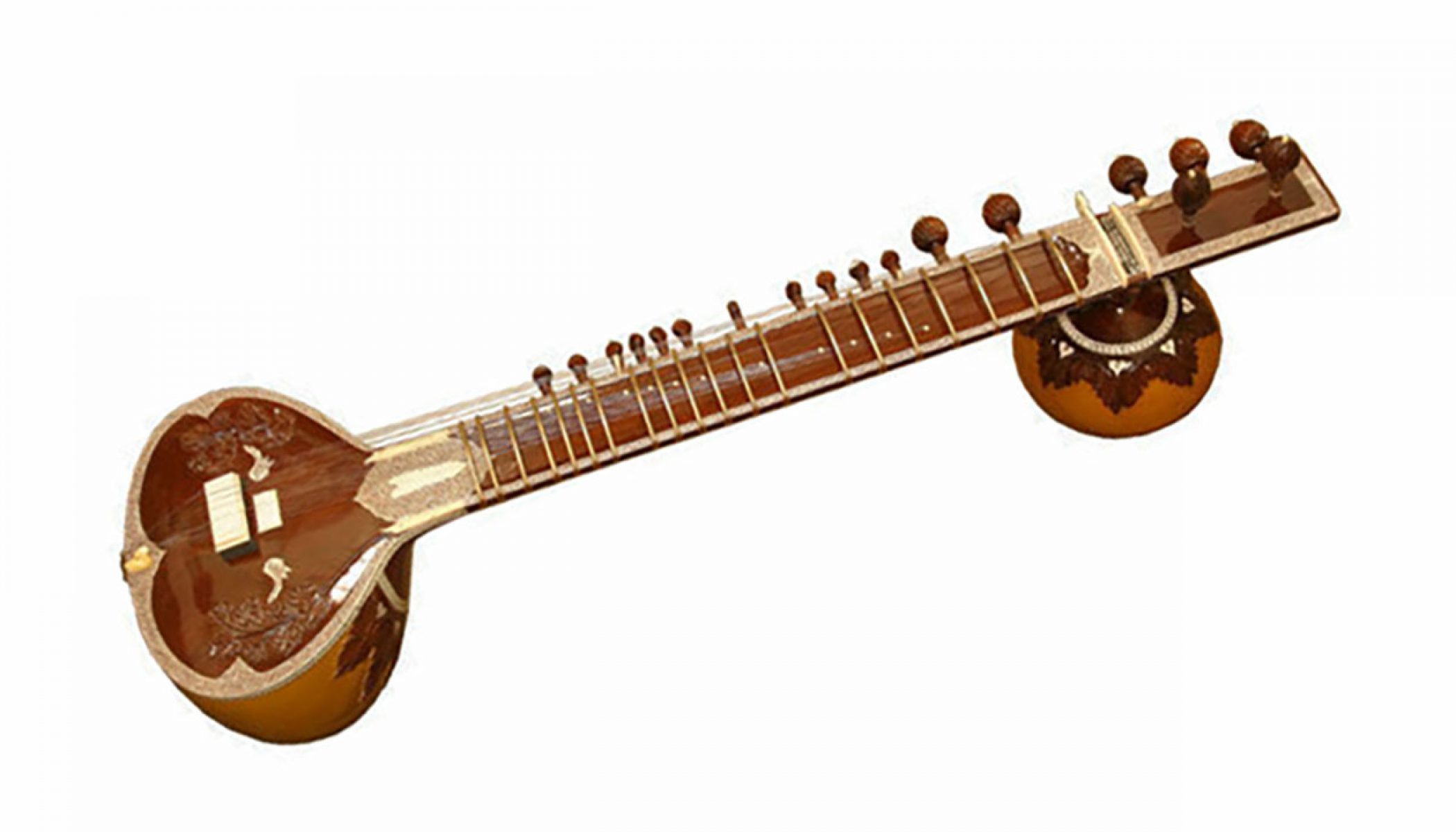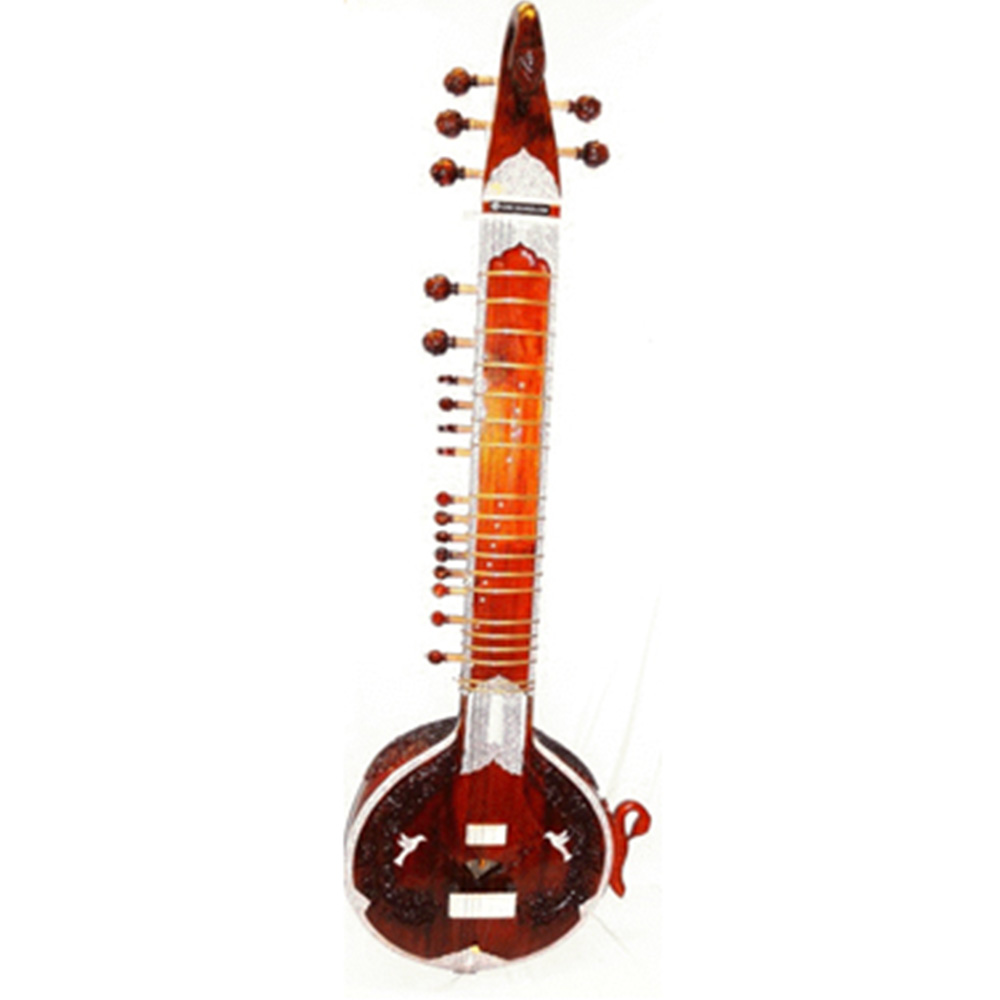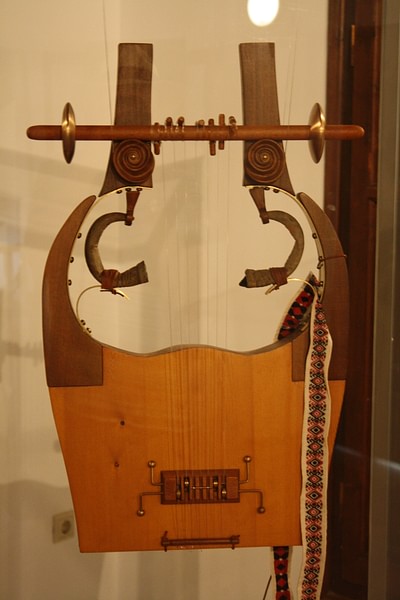- What is a Sitar?
- History of Sitar Instrument
- Importance of Sitar Instrument in Indian Classical Music
- What is Sitar Instrument made up of?
- Parts of a Sitar Instrument
- How many strings are there in Sitar Instrument?
- How to tune a Sitar Instrument?
- 3 types of Sitar Instruments
- Is sitar difficult to learn?
- How is Sitar played?
- What is the cost of a Sitar Instrument?
- FAQs
What is a Sitar?
Sitar is a commonly used stringed instrument in South Asian countries such as Bangladesh, India, and Sri Lanka. The Sitar instrument is a plucked stringed instrument that contains movable frets and a gourd resonator. “Sitar” is derived from the Persian word “Sehtar”(seh+tar) meaning “three-stringed”. Sitar received its name because the first used instruments has only three main playable strings to produce a melody.
History of Sitar Instrument

In India, the sitar can be traced back to the Mughal period, around 700 years ago. Many people believe that sitar was developed from Persian lutes which were commonly played in the Mughul courts. However, contrary to this belief, there is considerable evidence that supports Chitra Veena to be the precursor of a sitar.
As per early records, the sitars blossomed in the 16th and 17th centuries and arrived at the present known form in the 18th century due to the efforts of “Amir Khusru” who is Tansen’s grandson. He is the most famous Hindustani performer and was involved in adjusting the Veena to plan the present-day Sitar. His work led to the creation of a traditional Sitar which contains 5 melody strings that can be tuned to Ma-Sa-Ma-Sa-Pa.
Amir Khusru’s grandson Masit Khan has further contributed to the field of music. He has composed many slow gats in dhrupad style which was popular in the early times. This style is popular even today and is called the Masitkhani gat. His son Bahadur Khan continued to develop this genre.
Other important sitar personalities include Rahim Sen and Amrit Sen who altered the stringing and tuning of the sitar and thus, introduced many new playing techniques. Finally, Renuka Punwani from India created a world record by playing the sitar continuously for 25 hours at the age of 72.
Importance of Sitar Instrument in Indian Classical Music
Sitar is especially utilized in Hindustani classical music performances and it is known for generating a wonderful, vibratory tone. Additionally, the northern Indian traditional dance, Kathak, uses sitar as a solo instrument or along with a tambura as well as a tabla. Mezrab (zakhmeh) is a plectrum that sitarist uses to play the instrument. The Mezrab is made of a thick steel or brass wire. Most high-quality Sitars are constructed from a combination of teak and mahogany wood or toon wood. Teak is a rear wood and has great economic importance in the making of a sitar instrument. A storage case is required to hold the sitar sturdy and safe.
What is Sitar Instrument made up of?
Sitar is a long-necked instrument with an interesting construction, that is approximately 4 feet long. It has a varying number of strings but 18 is a usual number. It has three to four playing strings and drone strings. The approach to tuning it is similar to other Indian stringed instruments. The strings are plucked with a plectrum, also called a mizrab.
Additionally, there are also a series of sympathetic strings lying underneath the frets. These strings are never played. However, they vibrate when the corresponding note is plucked. The frets are metal rods that have been bent into a crescent shape. The main resonator is made of a gourd and sometimes there is an additional one attached to the neck.
Parts of a Sitar Instrument

1. Kunti
Kuntis are the tuning pegs on a sitar. A Sitar two different pegs. Firstly, the larger kuntis for the main strings. Secondly, the smaller ones for the sympathetic strings. Furthermore, the larger kuntis are of three styles: the simple, fluted, and lotus.
2. Baj Tar Ki Kunti
This kunti is used for the main playing string. Thus, it is used more than any other peg.
3. Tar
Tar is the Hindi word for string. The numbers of strings on a sitar may vary, but 18 is the most common. These strings are of three types. Firstly, the drone strings, secondly, the sympathetic strings, and lastly, the playing stings. The playing strings are those that are fretted to produce melodies.
4. Baj Tar
The furthest string is known as the baj tar which means “the playing string”. It might be surprising to beginners to know that all of the playing is done on this one string.
5. Drone Strings
The strings that are strummed but not fretted, are known as drone strings. Two kuntis or pegs control these strings and are called the chikaris. The strings are raised above the neck onto two camel bone pegs. Drone strings are essential for any musical performance. They are periodically struck to provide a tonic base for the musical piece.
7. Tarafdar
The tarafdar are the sympathetic strings, that are never strummed. However, they vibrate whenever a corresponding note is played on the playing string. These are located underneath the frets, Therefore, fretting them to produce a sound is impossible.
8. Dandi
This refers to the neck of the sitar.
9. Tumba
The gourd that is attached to the neck of a sitar is known as a tumba. However, not all sitars have a tumba.
10. Parda
Parda is the frets on a sitar. They are metal rods that are bent and fastened onto the neck with a fishing line. The frets are adjusted to correct the pitch. A sitar has two frets, the Re and the Dha, which require adjustments as the musician changes the rag.
11. Gulu
The gulu is a wooden cowl that links the resonator to the neck. In a poorly constructed sitar, this part is too weak. Thus, the whole instrument goes out of pitch every time the sitarist meends.
12. Chota Ghoraj
The chota ghoraj is a flat bridge for the sympathetic strings. High-quality ones are made of antelope horns. However, due to the high cost of the material, Camel’s bones are used instead.
13. Bada Ghoraj (Main Bridge)
The bada ghoraj is similar in structure to the chota ghoraj and is used for the playing as well as the drone strings. It is raised so that the sympathetic strings are able to pass beneath.
14. Tuning Beads
A sitar contains several tuning beads that allow the player to make minor adjustments in pitch without having to use the large kuntis.
15. Tabkandi
The tabkandi is the faceplate. It is essential in determining the tone of the instrument. A thin tabkandi will produce a loud sound with poor sustain, while a thick one will have improved sustain, but a weaker sound.
16. Kaddu
The kaddu is the resonator. It is very delicate and should be protected against shock at all times.
How many strings are there in Sitar Instrument?

A sitar generally has 18 to 21 strings and 20 frets. Of the 21 strings, 5 are melody strings, 12 or 13 are sympathetic strings and one or two are drone strings.
Melody strings and drone strings are together known as main strings or playable strings.
Sympathetic strings, also referred to as Tarafdaar and Taarif, run below the frets. Their function is to change the melody produced by the main strings. Something to note is that sympathetic strings are generally not played by sitarists. Therefore, sympathetic strings are also called auxiliary strings.
Over time, the sitar comes under a great deal of pressure due to the strings stretched across it. Therefore, it will start to bend and become harder to play. In fact, even the best-made Sitars face the same problem, and will eventually require the neck to be replaced.
How to tune a Sitar Instrument?

Tuning of sitar changes depending on the sitarist’s school or style, preference and tradition. The main playing string is mostly tuned a perfect fourth above the tonic, while the second string is tuned to the tonic. Here, the tonic is referred to as ṣaḍja, ṣaḍaj. On the other hand, the drone strings are tuned to a perfect fifth.
Each time a player changes raga, he should re-tune the sitar. Strings are tuned using tuning pegs, and the main playing strings can further be fine-tuned by sliding a bead threaded on each string.
3 types of Sitar Instruments
There are 3 main types of sitar-
1. Kharak Pancham or Ravi Shankar style Sitar

This sitar is named after the prestigious sitarist and melodic legend Dr Ravi Shankar. It is the most popular type of sitar, that is usually well decorated with a decent arrangement of additional carving and penwork. The Ravishankar-style sitar has 7 playable strings with two extra bass strings, which produce extra bass-filled sound. It contains 13 sympathetic strings, 3 drone strings and four or five melody strings, as well as two sound boxes. These types of Sitars are also called instrumental style sitars. it contains an additional upper dried gourd which is attached to the back of the headstock.
2. Gandhar Pancham or Vilayat Khan style sitar or Gayaki style Sitars

This style of Sitars has only one soundbox. They contain 11 sympathetic strings, 4 drone strings, and two melody strings. Unlike the Ravi Shankar style sitar, the Vilayat Khan-style sitar contains just one gourd. The rear one is absent. It has less sympathetic strings than Ravi Shankar sitar and this type of Sitar does not contain bass strings. However, it contains an additional rhythmic string, called Chikari. Vilayat Khan-style sitars usually do not have any carved decorations.
3. Bass Sitar or Surbahar

The Bass sitar contains 4 playing strings, 10 to 11 sympathetic strings and 3-4 drone strings. People believe that Ghulam Muhammed Khan from Lucknow invented the Surbahar. These types of Sitars contain more extensive necks as well as thicker strings than the other two types of sitars. Bass type of sitars are harder to play and larger in size but produces excellent tonal music.
Is sitar difficult to learn?
Learning Sitar is impossible without guidance. This is because of the various challenges beginner players may face. The biggest challenge is bending (meend) the playing strings. Additionally, tuning the sympathetic strings, as well as the act of fretting can be quite difficult.
Despite these challenges, the basic principles of a sitar are straightforward and easy to learn with the right guidance. Furthermore, as there is no system of chords in Indian music, players do not have to worry about chord positions on the Sitar.
How is Sitar played?
First, get into comfortable folded legs position on the floor to utilize your entire body to support the sitar instrument. Use your right knee to support the neck of the sitar and place a Mizrab on your right index finger to play the strings.
Firstly, familiarise yourself with the playable strings of the instrument. Then, work on using the Sitars frets to play a wide variety of notes at different octaves. To do so, carefully push the strings against the frets with your left index and middle finger.
Once you gain complete knowledge of the types of strings, begin learning the different types of notes, so you can start playing the full song. You may also look at the video below.
What is the cost of a Sitar Instrument?
The Sitar costs vary a lot. The lowest end Sitars can be purchased at around USD 30 to USD 60. Higher-end Sitars can cost between USD 1000 to USD 1500.
FAQs
1. Is sitar and veena the same?

Both Sitar and Veena are stringed instruments of India. They differ in their making and the style of play. The veena is mostly used in Carnatic music, while the Sitar is commonly used in Hindustani music performances. The sound of the sitar is distinct and has more melody as there are additional strings underneath the frets that resonate with the main strings. Furthermore, in a sitar, one can fine-tune by altering the position of the frets, whereas, in the veena, this is not possible as the frets are fixed. Also, the frets are straight in a veena but are bent in the sitar.
2. Is guitar based on sitar?

No, a guitar is not based on a sitar. Instead, it is derived from the Guitarra Latina, a medieval instrument that contained a body and four strings. The word guitar is derived from the Spanish word guitarra, which came from the Arabic word qitar, which in turn was derived from the Greek word kithara which means lyre-like instrument.
3. How long does it take to learn how to play the Sitar?
Sitar is an instrument that requires continuous practice and lifelong learning. However, on average, a person can learn how to play the sitar in 5 years, provided they start learning very young and practice regularly.
4. What wood is sitar made from?
Sitars are made either from Cedarwood or Teak wood. Cedarwood is less dense and has its own personality of tone. On the other hand, teak wood is more dense & oily and produces a unique tonal quality.
5. Which sitar is best for beginners?
The Gandhar Pancham or Vilayat Khan style Sitar is a good, beginner-friendly instrument. It contains 6 main strings & 12 sympathetic strings, which produce magnificent acoustic sounds.
6. How should you choose a sitar?
Listen carefully.
Tune the sitar and judge the sound. It is necessary to play the instrument for a while before it starts “opening” and the full sound potential is revealed.
Check the positions of the frets.
When the sitar is in tune, check all the positions of all the frets by simply playing notes on each fret one by one. If the note is incorrect, then adjust the fret’s position. A well-made sitar has binding wires in the middle of 2 tuning pegs.
Measure the action.
When in tune, ensure that the height between the main playing string and the fret is between 8 and 11 mm. If the height is more then there might be a problem with the neck or the joint.
Play meend.
When in tune play full meend on all the frets. Check if the playing string touches the fret adjacent to the one you are pulling on. If this happens, then do not purchase the sitar.
Tuning pegs.
Try out all the tuning pegs. Check if they are running smooth and do not get stuck after a short turn. Furthermore, check if the tuning peg is round and perfectly straight.
Watch the joint.
The joint is the region at the back of the sitar where the neck meets the piece which holds the tumba. Ensure that there is no gap or crack in this region.
Heavy sitar.
Check the overall weight of the instrument. It should not be too heavy, but also not too light.
Neck bending.
When the sitar is in tune, take a look along the neck’s length to see if it is bending too much. This can be difficult for the untrained eye. While you might be under the impression that the neck is perfectly straight, in reality, it will be bending a very little bit. So, if you can discover a noticeable bending of the neck, do not buy the sitar.
7. How long do sitars last?
A sitar can be expected to last for 30 to 40 years. This primarily depends on the climate. Sitars will last longer in dry climates than humid ones. Furthermore, it is important to note that the neck of a sitar is under a lot of stress from the strings. Therefore, over time it will start to bend, throwing the frets off, thus, becoming harder to play. Eventually, the neck will need to be replaced.
8. What are sitar strings made of?
Sitar strings are made of wires of varying gauges. There are typically five to seven main strings as well as one or two drone strings used for rhythm. Additionally, there are 10-13 sympathetic strings below the frets.
9. How many octaves does a sitar have?
A sitar consists of 13 sympathetic strings, three drone strings and four melody strings as mentioned earlier. Therefore, it contains a range of four octaves.
10. Who are the main sitar players one should listen to?
There are many excellent sitar players in India as well as around the world. However, most people consider three musicians, Ravi Shankar, Nikhil Banerjee and Vilayat Khan to be the most influential sitarists. Vilayat Khan was the greatest advocate of the Etawa or Imdadkhani gharana, while Ravi Shankar and Nikhil Banerjee were students of Ustad Allaudin Khan of Maihar, and represented the Maihar Gharana. Ravi Shankar passed away in 2012 at the age of 92. Vilayat Khan dies at 76 in 2004. However, Nikhil Banerjee died a tragic early death in 1986. All these sitarists left behind a legacy of recordings coveted by music lovers worldwide.
11. What is Jawari?
Jawari is the buzzing sound that a sitar produces when the string vibrates on the flat bridge. “Jawari” means “glimmering” or “jewel-like”.
The jawari is influenced by the shape, the curve, and the angle at which the bridge is filed. Additionally, the length of the string rests on the bridge as well as the steepness of the curves also affect the quality of the sound produced by a sitar.
12. How can you learn sitar at home?
There are several online platforms you can use to learn the sitar. You can watch videos posted on Youtube or Vimeo to learn beginner notes. We have some videos below that you can take a look at if you are interested in learning the sitar.
Alternatively, you can find good paid and free sitar lessons on websites like Udemy, Superprof, Sharda, Takelessons etc. These are a great alternative to learning for a music school.

